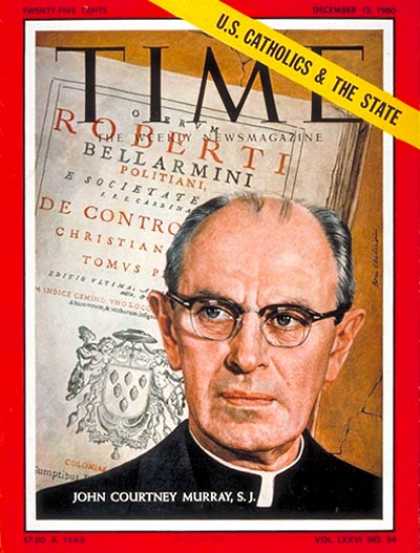 Featured on the cover of Time magazine, 50 years ago today, was a one-time associate editor of America magazine you might have heard of. The original portrait of John Courtney Murray, S.J., (1904-1967) by Boris Chaliapin, one of Time's regular cover artists, now hangs in the lobby of America House in New York. If you've not heard of this great American Jesuit theologian, who was for a time prevented from writing on issues of church and state (his primary field of interest and the subject of his book We Hold These Truths), whose ideas were eventually incorporated into the Second Vatican Council's "Declaration on Religious Liberty," and who was later officially "rehabilitated" by Pope Paul VI during his concelebration with the pope at a public Mass, here are pieces in America by the Msgr. Robert McElroy ("He Held These Truths"), Gregory Kalscheur, S.J. ("American Catholics and the State"), John Coleman, S.J. on what was at stake in the debates over religious liberty during Vatican II ("Religious Liberty") and Fr. Murray himself, in an article that concisely maps out his position in 1963 ("On Religious Liberty.") The time of his "silencing" is covered in Robert Nugent's new book Silence Speaks: Teilhard de Chardin, Yves Congar, John Courtney Murray and Thomas Merton. As McElroy, Kalscheur, Coleman show, his far-ranging ideas on church and state are particularly applicable today. And, as Nugent shows, the church often ends up incorporating into her teaching the very ideas that she rejected not long before. Finally, an excellent bio of Fr. Murray is here at the Murray Collection at the Woodstock Center in Georgetown.
Featured on the cover of Time magazine, 50 years ago today, was a one-time associate editor of America magazine you might have heard of. The original portrait of John Courtney Murray, S.J., (1904-1967) by Boris Chaliapin, one of Time's regular cover artists, now hangs in the lobby of America House in New York. If you've not heard of this great American Jesuit theologian, who was for a time prevented from writing on issues of church and state (his primary field of interest and the subject of his book We Hold These Truths), whose ideas were eventually incorporated into the Second Vatican Council's "Declaration on Religious Liberty," and who was later officially "rehabilitated" by Pope Paul VI during his concelebration with the pope at a public Mass, here are pieces in America by the Msgr. Robert McElroy ("He Held These Truths"), Gregory Kalscheur, S.J. ("American Catholics and the State"), John Coleman, S.J. on what was at stake in the debates over religious liberty during Vatican II ("Religious Liberty") and Fr. Murray himself, in an article that concisely maps out his position in 1963 ("On Religious Liberty.") The time of his "silencing" is covered in Robert Nugent's new book Silence Speaks: Teilhard de Chardin, Yves Congar, John Courtney Murray and Thomas Merton. As McElroy, Kalscheur, Coleman show, his far-ranging ideas on church and state are particularly applicable today. And, as Nugent shows, the church often ends up incorporating into her teaching the very ideas that she rejected not long before. Finally, an excellent bio of Fr. Murray is here at the Murray Collection at the Woodstock Center in Georgetown.
50 Years Ago: John Courtney Murray, SJ
The latest from america
This week, a music festival returns to the Chiquitos missions in Bolivia, which the Jesuits established between 1691 and 1760. The story of the Jesuit "reductions" was made popular by the 1986 film ‘The Mission.’
The world can change for the better only when people are out in the world, “not lying on the couch,” Pope Francis told some 6,000 Italian schoolchildren.
Our theology of relics tells us something beautiful and profound not only about God but about what we believe about materiality itself.
"3 Body Problem" is an imaginative Netflix adaptation of Cixin Liu's trilogy of sci-fi novels—and yet is mostly true to the books.








The coexistence within the one political community of groups who hold divergent and incompatible views with regard to religious questions – those ultimate questions that concern the nature and destiny of man within a universe that stands under the reign of God. (ix-x)
Today, American society is a good deal more diverse than it was when Murray was writing. Pluralism requires a level of tolerance and good will that is often absent from what passes as public debate today. Murray also stated in We Hold These Truths, “Society becomes barbarian when men are huddled together under the rule of force and fear” (13). It seems that large segments of our society today are huddled together in fear of the “other,” especially when the other wears a veil or a turban. I don’t know whether the barbarian of which Murray warned has won, (although I certainly hope not!) but I do think that ''he'' is pounding at the gate. Murray’s ongoing relevance may lie in this area: as a challenge to future generations to remain vigilant in the defense of religious liberty and of the conditions that are necessary to support it. I am concerned that we may have lost the level of civility necessary to have the conversations that Murray thought were necessary to preserve the civil society that he wrote about.
http://www.time.com/time/magazine/article/0,9171,871878,00.html